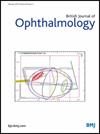Fifteen-year incidence of presbyopia in south India: the Andhra Pradesh Eye Disease Study
IF 3.7
2区 医学
Q1 OPHTHALMOLOGY
引用次数: 0
Abstract
Purpose The Andhra Pradesh Eye Disease Study III (APEDS III) is a 15-year follow-up involving 5395 participants (83.7%) first examined in APEDS I (1996–2000). Our aim was to determine the incidence of presbyopia and sociodemographic risk factors in those aged 16 years and above at baseline. Methods Presenting distance visual acuity (PDVA) was measured at 3 m while near visual acuity was assessed at 40 cm using standard logarithm of minimum angle of resolution charts. Participants at risk of incident presbyopia were those in whom PDVA was 20/40 or better without presbyopia at baseline. Incident presbyopia was defined as the presence of any degree of presbyopia in the better eye at follow-up (APEDS III), in participants who did not have presbyopia at baseline (APEDS I). Results The mean baseline age (SD) of participants was 28.9±7.5 years and 55.2% were female. The 15-year crude cumulative incidence of presbyopia was 50.9% (95% CI 48.7% to 53.0%), and the crude incidence rate was 51.8 (95% CI 51.3 to 52.4) per 100 person-years. The independent baseline risk factors for the incidence of presbyopia were being aged 30–39 years (OR 2.9; 95% CI 2.4 to 3.6) or 40–49 years (OR 1.5; 95% CI 1.0 to 2.2), having no formal education (OR 2.5; 95% CI 1.7 to 3.8), having only primary education (OR 2.1; 95% CI 1. to 3.2) and having hypertension (OR 1.3; 95% CI 1.0 to 1.7). Conclusions The incidence of presbyopia was relatively high in this Southern Indian population. The findings could be used to design future eye care strategies to screen people at risk and provide appropriate and timely intervention. Data are available on reasonable request. The data supporting the findings of this study are available on reasonable request.求助全文
约1分钟内获得全文
求助全文
来源期刊
CiteScore
10.30
自引率
2.40%
发文量
213
审稿时长
3-6 weeks
期刊介绍:
The British Journal of Ophthalmology (BJO) is an international peer-reviewed journal for ophthalmologists and visual science specialists. BJO publishes clinical investigations, clinical observations, and clinically relevant laboratory investigations related to ophthalmology. It also provides major reviews and also publishes manuscripts covering regional issues in a global context.

 求助内容:
求助内容: 应助结果提醒方式:
应助结果提醒方式:


